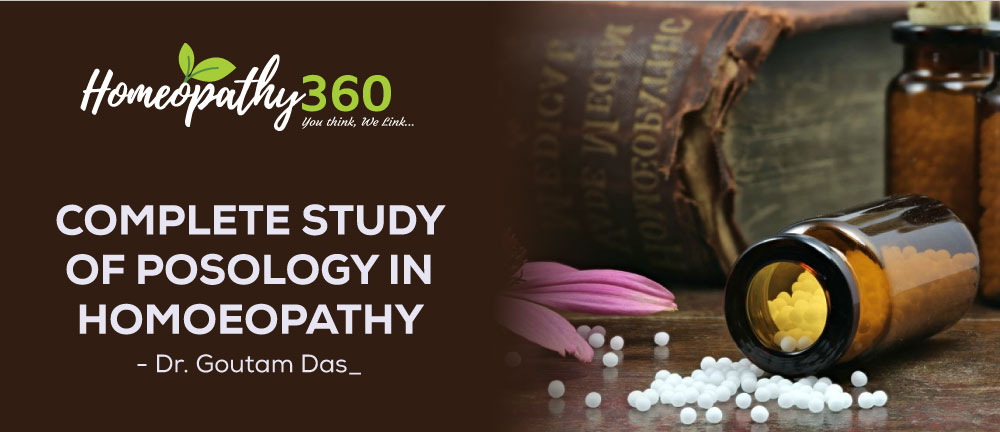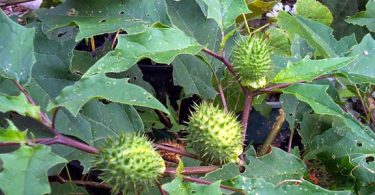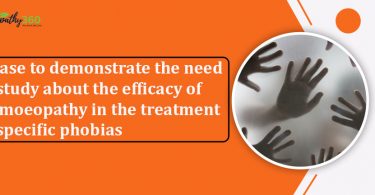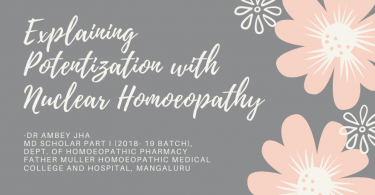
Keywords: Posology–definition-physiological-therapeutic-pathogenetic-action of the drugs-homoeopathic therapeutic doses–choice of potency-repetition of doses-effect of the remedy-law of doses.
Introduction: [1 p183]
There are three essential elements of Homoeopathy are the principle, the remedy and the dose.
And the three are of equal importance.
- It is as unreasonable to expect to cure all cases with any two or three potencies as it is to expect to cure all cases with any two or three remedies.
- A well selected remedy may fail or even do injury, because of wrong dosage.
- Dose as well as remedy must be adjusted to the patient’s need.
Definition: [2 p183]
‘Posology’ came from the Greek word ‘posos’ means ‘how much’ and ‘logos’ means ‘science’. Posology is the doctrine of the ‘science of doses’, which teaches us about the selection, administration and repetition of the doses.
Science of Doses: [3 p184]
The homoeopathic doctrine of dosage, like the law of cure, was based upon the discovery of the opposite action of large and small doses of medicine.
- It is another application in medicine of the Law of Mutual Action – the third Newtonian law of motion – “action and reaction are equal and opposite.”
Although the physiological antagonism between large and small doses is an illustration of the homoeopathic law of posology:
- The use of drugs in “physiological doses” has nothing to do with their homoeopathic use, because homoeopathic remedies are never used in physiological doses.
Physiological, therapeutic and pathogenetic action of the drugs: [4, 5. 6 pp185, 186, 186]
Clearly understand of the subject that a distinction be made between three terms, physiological, therapeutic, and pathogenetic, used by the two schools of medicine to express the nature of the action of the drugs.
The word “physiological” as currently used in medicine in relation to drug action and dosage is misleading and inaccurate.
- The word is suggestive of something normal and healthy.
- It’s use tends the fact that the kind of drug action is essentially a toxic action and therefore really painful and injurious.
- The “physiological action” of a drug is not its therapeutic or curative action.
- It is exactly the opposite of a curative action, and is never employed in homoeopathic practice for therapeutic purposes.
The word “pathogenetic” (Gr., pathos, suffering, and genesis, origin, “producing suffering”) as properly describing the character of such drug action:
- The “suffering” of the organism produced by the drug is expressed in symptoms, which are the language of disease.
- In homoeopathic parlance, therefore, these are termed “pathogenetic symptoms,” a term which is preferable because it is accurate and truthful.
Therapeutic means curative, healing, alleviating:
- A pathogenetic action is never curative.
- The action of a drug may be pathogenetic (toxic), or therapeutic (curative), depending upon the size and strength of the dose, the susceptibility of the patient and the principle upon which it is given.
In the homoeopathic treatment of disease a drug is never given for its pathogenetic action. [[4 p186]]
- Pathogenetic doses may be given, however, for experimental purposes to a healthy person, in making what are called provings.
- In treating disease homoeopathically the object is not to produce symptoms but to remove them.
- By means of the similar remedy in the minimum dose it is possible to do this in a direct manner without producing symptoms.
Homoeopathic therapeutic dose: [7 p188]
Homoeopathy requires in proper amount, but in the proper direction and proper time.
The homoeopathic dose, therefore, is always a sub-physiological or sub-pathogenetic dose:
- That is, a dose so small as not to produce pathogenetic symptoms.
- For one desires, not to produce more symptoms, but only to remove and obliterate symptoms already existing.
- It must also be given in a dose so small as not to produce a severe aggravation of the already existing symptoms.
Choice of the potency: [8 p191]
Five considerations influence us in the choice of the dose:
- The susceptibility of the patient.
- The seat of the disease.
- The nature and intensity of the disease.
- The stage and duration of the disease.
- The previous treatment of the disease.
Susceptibility of the patient: [9 p192]
According to Jahr,
- Where the symptoms are not clearly developed and there is an absence or scarcity of characteristic features; or
- Where two or three remedies seem about equally indicated, susceptibility and reaction may be regarded as low (third to twelfth) potency.
But when the symptoms of a case clearly indicate one remedy, whose characteristic symptoms correspond closely to the characteristic symptoms of the case, we give the high potencies – thirtieth, two hundredth, thousandth, or higher, according to the prescriber’s degree of confidence and the contents of his medicine case.
Dr Stuart Close advice that the finer, more peculiar and more characteristic symptoms of the remedy appear in a case, the higher the degree of susceptibility and the higher the potency.
Susceptibility is modified by age: [10 p194]
Generally speaking:
- Susceptibility is greatest in children and young, vigorous persons and diminishes with age.
- Children are particularly sensitive during development, and the most sensitive organs are those which are being developed.
- Therefore the medicines which have a peculiar affinity for those organs should be given in the medium or higher potencies.
Susceptibility is modified by constitution and temperament: [11 p194]
The higher potencies are best adapted to;
- Sensitive persons of the nervous, sanguine or choleric temperament.
- Intelligent, intellectual persons, quick to act and react.
- To zealous and impulsive persons.
Lower potencies and larger and more frequent doses correspond better to;
- Torpid and phlegmatic individuals.
- Dull of comprehension and slow to act.
- To coarse fibered, sluggish individuals of gross habits.
- Who possess great muscular power but who require a powerful stimulus to excite them.
- Large amount of stimulants like whiskey, and show little effect from it.
- When ill they often require low potencies or even, sometimes, material doses.
Susceptibility is modified by habit and environment: [12 p194]
It is increased by;
- Intellectual occupation.
- By excitement of the imagination and emotions.
- By sedentary occupations.
- By long sleep.
- By an effeminate life.
- Such persons require high potencies.
Susceptibility is modified by pathological conditions: [13 p194]
| Pathological conditions | Susceptibility |
| Valvular heart disease | Digitalis no effect is produced by any potency. |
| Intercurrent reaction remedies. | Given in potentiated form and small doses, resort to the crude drug and increase the dose to the point of reaction. |
| Intercurrent remedies. | In high potency – Laurocerasus, Carbo vegetabilis, Tuberculinum, Medorrhinum were given. |
Susceptibility, Habit and Environment: [14 p199]
| Habit and environment | Susceptibility and potency |
| Long and severe labour out-of-doors, who sleep little and whose food is coarse. | Less susceptible, require low potencies. |
| Continual influence of drugs, such as tobacco workers and dealers. | Require low potencies. |
| Particular drug influence. | High potency of the same, best antidote. |
| Idiots, imbeciles and the deaf and dumb. | Low degree of susceptibility. |
| Crude drugs of allopathic, homoeopathic or “bargain-counter” prescription. | Require high potencies. |
| Low potencies when exhausted. | Require high potencies. |
| For antidote. | High/low vice versa. |
The question is entirely one of susceptibility: [15 p201]
One must learn how to judge the degree of susceptibility as homoeopathic prescribers.
- By constitution, temperament, degrees of his susceptibility as modified by the character and stages of his disease and by previous treatment.
- At one stage he may need a low potency, as already pointed out, and at another a high potency.
- As, for example, that the lower preparations should be used in chronic disease with tendency to disorganization of tissues and in acute disease.
Repetition of doses: [16 p202]
The only rule which can be laid down with safety is to repeat the dose only when improvement ceases. To allow a dose, or a remedy, to act as long as the improvement produced by it is good practice.
- One of the most difficult things is to learn to wait needs wisdom, courage and patience.
Effect of the remedy: [17 p205]
- First to be determined whether the remedy has acted at all or not.
- If it has not acted, we have next to determine whether the failure to act is due to an error in the selection of the remedy, or to the selection of the wrong potency of the remedy.
- If, in carefully reviewing our symptom-record, we find the remedy rightly chosen.
- We change the potency to a higher or lower potency, as circumstances may require, after a reconsideration of the patient’s degree of susceptibility.
Upon the character of those changes depends the further course of action. A remedy shows its action:
- By producing new symptoms.
- By the disappearance of symptoms.
- By the increase or aggravation of symptoms.
- By the amelioration of symptoms.
- By a change in the order and direction of symptoms.
The law of dosage: [18 p208]
The right dose must and can be nothing else than that amount of the indicated quality (or remedy) which is equal to the amount of the force of the cause of the disease, and qualitatively runs counter to its course and motions.”
- We possess thus, in the very dose, or quantity of the morbid cause, the measure for the quantity of the dose of the drug to be used.” (and vice versa).
- How then are we to measure these quantities!
- The law of similiars or equivalent actions reveals the answer, and mechanical potentiation according to scale gives the unit of measurement.
- The real and efficient quantity of the morbid cause necessary to produce the disease cannot be greater than the quantity of the medicine necessary to cure it!
Conclusion: [19 p210]
This conception, as a logical conclusion, enables us to put the matter upon an experimental basis and draw further conclusions as to the size of the dose.
“Low potencies acted best in acute diseases.”
- In the grosser type of the individual and his lower degree of susceptibility, as well as the lower grade of his disease process; he required a grosser, more material, and lower form of a remedy to cure him.
Infants and aged persons being of low vitality and feeble reactive powers, required low potencies for their cure:
- Have seen curative effects of high potencies in the aged as in the young, when both the remedy and the potency were indicated.
Again one must individualise:
- Low potencies will not cure all acute diseases, all infants, nor all aged persons.
- Nor will high potencies cure all forms of disease in all persons.
- All potencies are required for the cure of disease, and any potency may be required in any given case.
References
1) Close Stuart, The Genius of Homoeopathy. Low Price Ed. New Delhi: B. Jain Publishers Pvt. Ltd.; August 2002 [1 p183], [2 p183], [3 p184], [4, 5. 6 pp 185, 186, 186], [7 p188], [8 p191], [9 p192], [11 p194], [12 p194], [13 p194], [14 p199], [15 p201], [16 p202], [17 p205], [18 p208], [19 p210]
About Author:
Dr Goutam Das M.D. (Homoeopathy)
Professor, HOD, Dept. of Organon of Medicine





